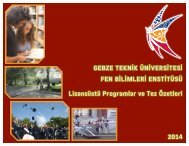GTÜ FBE Lisansüstü Programlar ve Tez Özetleri
Create successful ePaper yourself
Turn your PDF publications into a flip-book with our unique Google optimized e-Paper software.
Moleküler Biyoloji <strong>ve</strong> Genetik ABD Yüksek Lisans Programı<br />
Molecular Biology and Genetics Master of Science<br />
<strong>Tez</strong> Başlığı<br />
BREVIBACILLUS LATEROSPORUS TÜRÜNDEKİ SİDEROFOR ÜRETİMİNİN<br />
BELİRLENMESİ VE CİVA, NİKEL, KOBALT, DEMİR AĞIR METALLERİ<br />
VARLIĞINDAKİ DEĞİŞİMİ<br />
Thesis Title<br />
DETECTİON OF SIDEROPHORE PRODUCTION BY Brevibacillus<br />
laterosporus AND EFFECT OF MERCURY, NİCEL, COBALT, IRON HEAVY<br />
METALS ON SİDEROPHORE PRODUCTION<br />
Öğrenci Adı / Student’s Name Bahadır AYDIN<br />
<strong>Tez</strong> Danışmanı / Thesis Supervisor<br />
Yrd. Doç. Dr. Fatma İnci ÖZDEMİR<br />
Eş-Danışman / Co-Advisor<br />
ÖZET<br />
Sideroforlar, canlı organizmalarda genel olarak demir bağlama özellikleri ile bilinen<br />
çok çeşitli kimyasal yapı ihtiva eden ekstrasellüler sekonder metabolitlerdir. Bu<br />
bileşikler mikroorganizmalar, mantarlar <strong>ve</strong> bitkilerde yaygın olarak bulunmaktadır.<br />
Bu tez çalışmasında, Brevibacillus laterosporus tarafından siderofor üretiminin<br />
tespiti <strong>ve</strong> çeşitli metallerin (Fe, Co, Ni, Hg) siderofor üretimi üzerine etkilerinin<br />
incelenmesi amaçlanmıştır. Cıva metali nikel, kobalt <strong>ve</strong> demir metallerinin aksine<br />
biyolojik fonksiyon göstermeyen bir metaldir. Ayrıca cıva toksik etkileri bakımından<br />
önemli bir metaldir <strong>ve</strong> bu etkiler çevresel zarara yol açmaktadır. Çalışmada ilk<br />
olarak Uni<strong>ve</strong>rsal CAS analizi ile siderofor varlığı tespit edilmiş <strong>ve</strong> Arnow analizi ile B.<br />
laterosporus'un üretmiş olduğu sideroforun katekol tipi olduğu tespit edilmiştir. B.<br />
laterosporus tarafından maksimum siderofor üretimi metal içermeyen besi<br />
ortamında 48. saatte % 50 olarak belirlenmiştir. B. laterosporus'un farklı metal<br />
konsantrasyonlarında siderofor üretimi incelendiğinde ise en yüksek siderofor<br />
üretimi 5 µM cıva varlığında % 46.6, 0.5 mM Nikel varlığında % 23, 0.1 mM Kobalt<br />
varlığında %35.7, 2.5 µM demir varlığında %31 olarak tespit edilmiştir. Cıva (5 µM)<br />
ile yapılan biyosorpsiyon deneyinde ise en yüksek cıva alınımı en yüksek<br />
siderophore üretiminin gözlendiği 48. saatte % 40 olarak gözlenmiştir. Bu <strong>ve</strong>riler<br />
sideroforların toksik metallerin alınımıyla ilişkili olduğuna dair yeni bir sonuç ortaya<br />
çıkarmış, sideroforların çevresel ağır metallerle etkileşim gösterdiğini ortaya<br />
ABSTRACT<br />
Siderophores are known with iron chelation properties and they are extracellular<br />
secondary metabolites which consist of various chemical structures. These<br />
compounds are produced by microorganisms, fungi and plants. In this thesis study,<br />
we aimed to determine siderophore production of Brevibacillus laterosporus and<br />
effects of certain heavy metals (Fe, Co, Ni, Hg) to this production. On the contrary of<br />
nickel, iron and cobalt, mercury does not show biological function. Mercury ha<strong>ve</strong><br />
also toxic impacts and causes environmental hazards. In this study firstly, existence<br />
of siderophore was detected with Uni<strong>ve</strong>rsal CAS assay and siderophore compund<br />
was classified as cathecol type. Maximum siderophore production was determined<br />
50 % at 48 in the metal free growth media. When we examine the effect of metals on<br />
siderophore production, maximum siderophore production was obser<strong>ve</strong>d with 5<br />
µM mercury as 46.6 %, with 0.5 mM nickel as 23 %, with 0.1 mM cobalt and with 2.5<br />
µM iron as 31 %. In the phase of mercury biosorption experiment, maximum<br />
mercury biosorption was obser<strong>ve</strong>d at 40 % le<strong>ve</strong>l in 5 µM mercury containing media<br />
at 48. hour. B. laterosporus ha<strong>ve</strong> substantial biosorption capacity and can<br />
accumulate such of these metals. At this study, maximum siderophore production<br />
was obser<strong>ve</strong>d at 5 µM mercury containing media and maximum mercury<br />
biosorption was obser<strong>ve</strong>d at same media. These datas shows, a new result that<br />
siderophores are related with toxic metal uptake, and usable for removing of heavy<br />
256




